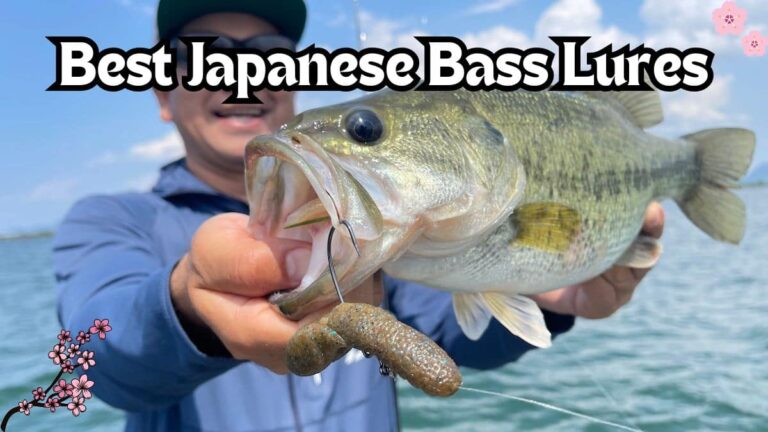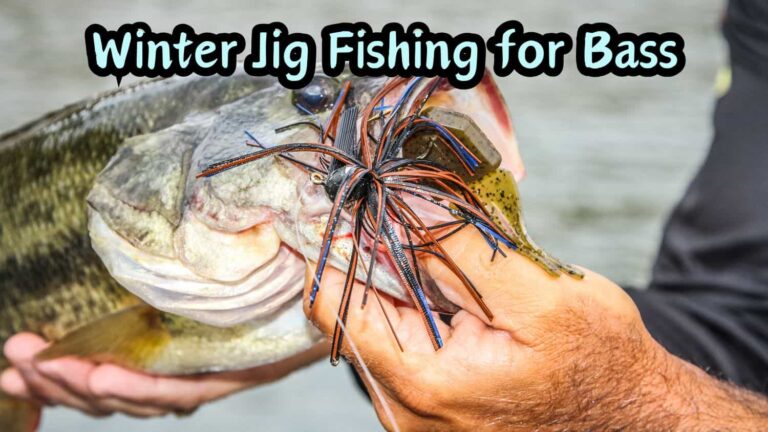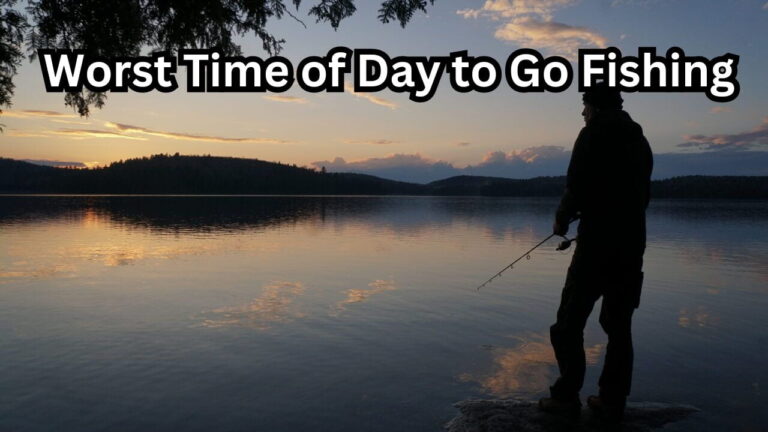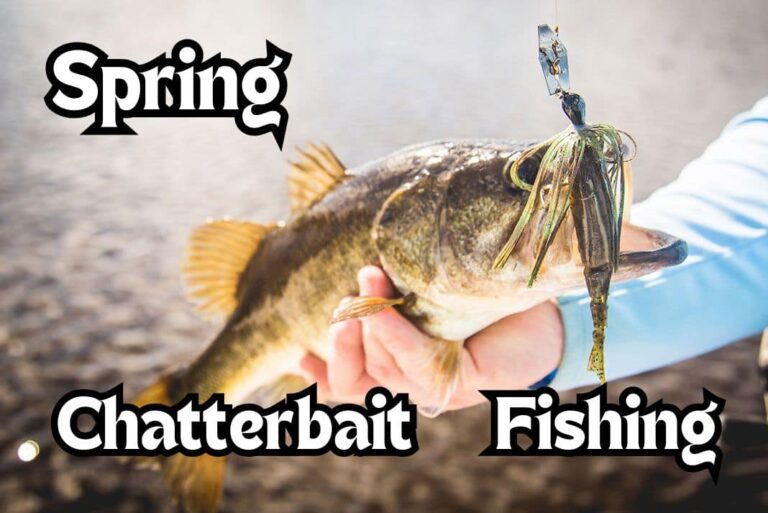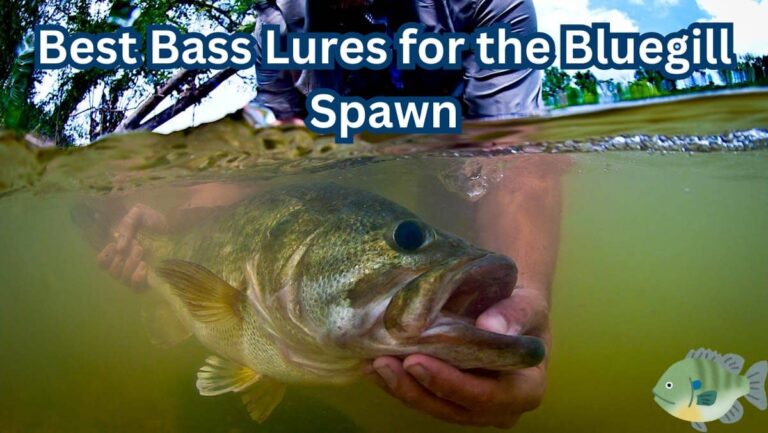Topwater Lures for Bass: Complete Guide to Topwater Fishing
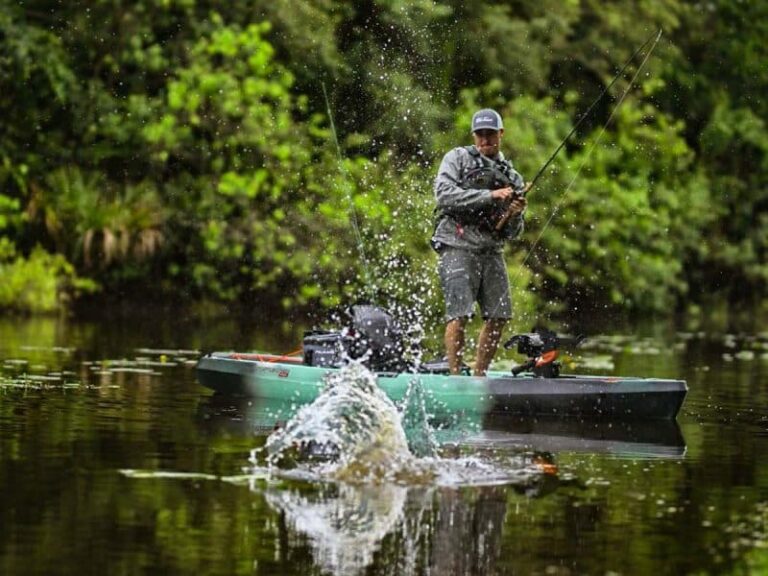
Nothing beats a topwater bite. Seeing a bass crush your bait and cause a big, loud splash gets my heart pounding every time.
Not only are topwater lures the most fun ways to catch bass, but they can often be the best way to catch them.
But you need to know how, what, and when to fish them.
Overview of Topwater Fishing
Simply put, top water lures are fished on the surface of the water. Most of them float, but there are a couple that use spinning blades to keep them up on the surface.
These lures create a clear and easy target for bass, because there is nowhere for the prey (your lure) to escape to.
When to Use Topwater Lures for Bass
Knowing when to use topwater lures for bass fishing can significantly increase your chances of success. While bass can be caught on topwater lures throughout the day, there are specific scenarios and conditions where these lures truly shine.
- Low-light conditions: Dawn and dusk are prime times for topwater fishing. During these periods, bass are more active near the surface, making them more receptive to topwater presentations.
- Warm water temperatures: In warmer months, especially during the spawning season, bass tend to be more aggressive and willing to strike at surface lures. The warmer water temperatures increase their metabolism, making them more active hunters.
- Overcast days: Cloudy or overcast conditions reduce the amount of light penetrating the water, making bass feel more secure and increasing their willingness to strike at surface lures.
- Calm water or gentle ripples: When the water’s surface is calm or has a slight ripple, it creates a perfect setting for topwater lures. The minimal disturbance allows for better visibility and a more realistic presentation.
- Presence of baitfish or insects near the surface: If you observe baitfish or insects congregating near the top of the water column, it’s a clear sign that bass are actively feeding in that area. Using topwater lures that mimic the prey species can yield excellent results.
- Vegetation and structure: Topwater lures excel in areas with vegetation, such as lily pads, grass, or submerged timber. These structures provide cover for bass and serve as ambush points, making them more likely to strike at surface lures.
Types of Topwater Lures for Bass
There is a fairly wide variety of top water lures, and they each have unique advantages and situations to use them.
Check out the company that makes my current favorite top water lure: Headbanger lures.
1. Popper
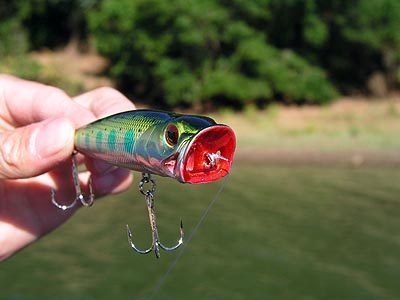
Poppers are topwater lures known for their concave or cupped face, which creates a popping sound and splashing action on the water’s surface.
These lures mimic distressed prey, attracting bass with their unique commotion. Poppers are versatile, effective in both calm and choppy waters, and excel in areas with vegetation and cover.
Mastering the retrieval techniques can lead to explosive strikes and thrilling bass fishing experiences.
Best Situations to Use Poppers
- Calm water: Poppers are highly effective in calm water conditions where their popping and splashing action can create maximum surface disturbance. The commotion attracts bass, even from a distance, increasing the chances of a strike.
- Vegetation and cover: Poppers shine in areas with vegetation, such as lily pads, grass, or submerged structure. The popping sound and surface disturbance help draw bass out of cover, enticing them to strike. Work the lure near these prime ambush spots for optimal results.
- Low-light periods: Dawn and dusk, or overcast days, provide ideal lighting conditions for popper fishing. Bass tend to be more active near the surface during these times, making them more receptive to the enticing action and sound of poppers.
- Aggressive feeding behavior: When bass are actively feeding on baitfish or insects near the surface, poppers can trigger their predatory instincts. Match the size and color of the local prey to increase your chances of success.
- Post-spawn period: After the bass have completed spawning, they often exhibit aggressive behavior. Poppers can be highly effective during this post-spawn period when bass are actively feeding and searching for vulnerable prey.
2. Walking Baits
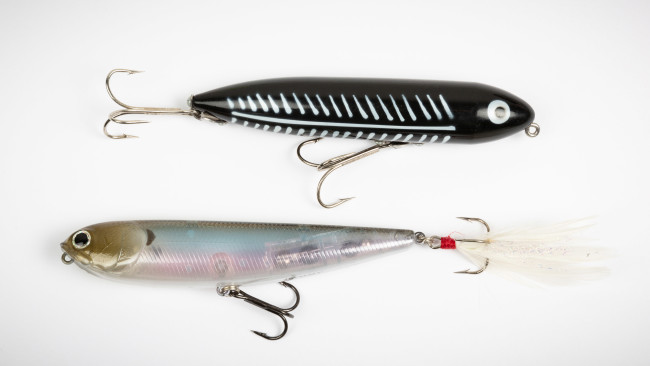
Walking baits, also known as walk-the-dog lures, are slender, long-bodied topwater lures designed to mimic injured prey.
With their side-to-side, zigzagging motion, they create an enticing action on the water’s surface.
These versatile lures are effective in various water conditions and can draw strikes from bass by imitating the movements of wounded baitfish.
Their long-casting ability and lifelike finishes make them a popular choice among anglers seeking thrilling topwater action.
When to Use Walking Baits
- Calm to slightly choppy water: Walking baits are most effective when there is minimal surface disturbance. The calm or slightly choppy water conditions allow the lure to create its signature side-to-side, walking action, drawing the attention of bass.
- Active feeding periods: When bass are actively feeding near the surface, such as during dawn and dusk or when baitfish are present, walking baits can trigger aggressive strikes. The realistic motion of the lure imitates injured prey, enticing bass into action.
- Clear water: In clear water conditions, bass rely heavily on their vision to locate prey. The lifelike appearance and enticing action of walking baits can generate strikes from bass that are visually searching for prey.
- Areas with submerged structure: Walking baits are effective in areas with submerged structure, such as weed beds, fallen trees, or rocky areas. The side-to-side movement of the lure tempts bass hiding in these structures to come out and strike.
- Post-spawn period: After the spawning season, bass often display aggressive feeding behavior. Walking baits can capitalize on this by imitating vulnerable baitfish or injured prey, triggering strikes from post-spawn bass.
3. Buzzbaits
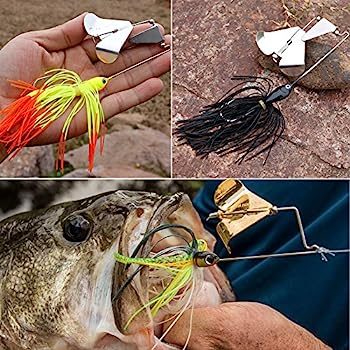
Buzzbaits are topwater lures designed to create surface commotion and mimic distressed prey.
With their spinning metal blade and buzzing sound, they attract bass by imitating injured or fleeing prey.
Buzzbaits excel in areas with vegetation and are highly effective during low-light conditions, offering anglers the opportunity for explosive surface strikes and thrilling battles with bass.
When to Use Buzzbaits
- Low-light conditions: Buzzbaits excel during dawn, dusk, or overcast days when visibility is reduced. Bass are more active near the surface during these times, making them more likely to strike at the buzzing commotion created by the lure.
- Areas with vegetation: Buzzbaits are ideal for fishing in areas with heavy vegetation, such as lily pads, grass, or weed beds. The lure’s design allows it to glide across the surface, avoiding snags and enticing bass hiding within the vegetation.
- Shallow water: Buzzbaits are effective in shallow water, typically less than six feet deep. They skim across the water’s surface, creating a wake and attracting bass that are looking for prey in these shallower areas.
- Active feeding periods: When bass are actively feeding on baitfish, frogs, or insects near the surface, buzzbaits can trigger aggressive strikes. The buzzing sound and surface disturbance mimic the movements of vulnerable prey, enticing bass into action.
- Aggressive bass behavior: Buzzbaits are particularly effective during times when bass exhibit aggressive behavior, such as the pre-spawn or post-spawn periods. The lure’s enticing action and noise provoke aggressive strikes from bass protecting their territory or feeding aggressively.
4. Topwater Frog
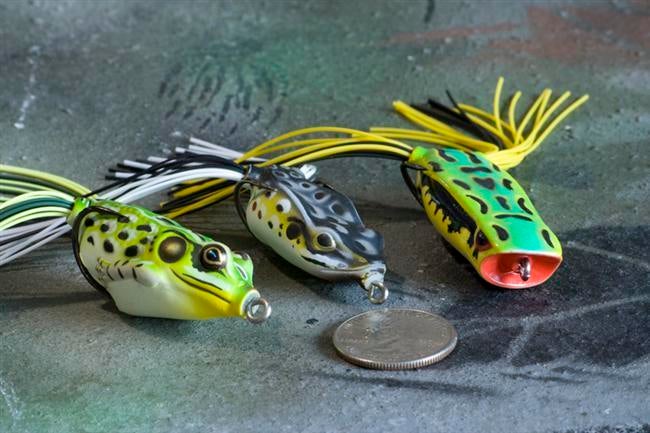
Topwater frogs are specialized lures designed to mimic frogs, a favored meal of bass.
With their soft, hollow bodies and lifelike appearance, they float on the water’s surface and navigate through vegetation.
These lures feature a unique walking or popping action when retrieved, imitating the movement of real frogs and enticing bass to strike, especially in areas with heavy vegetation.
When to Use Topwater Frogs
- Heavy vegetation: Frogs excel in areas with thick vegetation, such as lily pads, grass mats, or weed beds. The weedless design and floating capabilities of frogs allow them to navigate through cover without getting snagged, making them ideal for targeting bass hiding in these areas.
- Warm weather: Frogs are particularly effective during warmer months when bass are more active and seeking prey near the water’s surface. As temperatures rise, frogs become a prominent food source for bass, making them more likely to strike at frog imitations.
- Low-light conditions: Dawn, dusk, or overcast days provide ideal lighting conditions for frog fishing. Bass are more active near the surface during these times, and the silhouette of a frog against the dimmer light can trigger aggressive strikes.
- Post-spawn period: After the spawning season, bass often remain in shallower areas and actively feed. This is an excellent time to use frogs as they imitate the natural prey found in these areas, drawing aggressive strikes from territorial bass.
- Areas with open water pockets in vegetation: Look for open pockets within dense vegetation or scattered patches of vegetation. These areas act as ambush points for bass, and frogs presented in these pockets can elicit explosive strikes.
5. Prop Baits
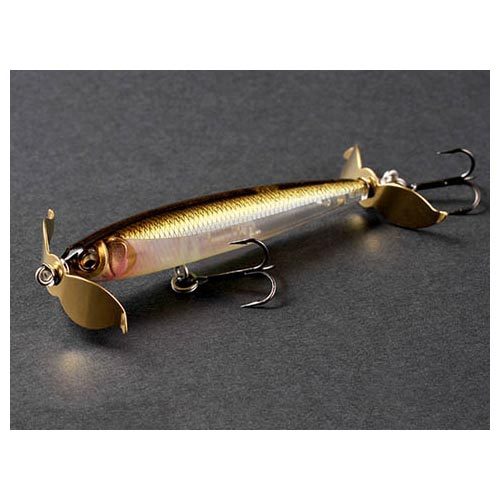
Prop baits are topwater lures with spinning blades or propellers that create surface commotion and enticing sound.
Their versatile design makes them effective in various water conditions, attracting bass from a distance.
By mimicking struggling prey and using a steady retrieve, prop baits provide thrilling topwater action for anglers.
Techniques When Using Topwater Lures for Bass
Using topwater lures can be an exciting and effective way to target bass. Here are some valuable tips and techniques to enhance your success with topwater lures:
Retrieval Techniques
- Walk-the-dog: This technique is commonly used with walking baits and involves rhythmic twitches of the rod tip to create a side-to-side, zigzagging motion. Coordinate your rod twitches with reel turns to achieve a smooth, gliding action that imitates the movement of injured prey.
- Popping: Poppers are best retrieved by imparting short, sharp jerks or pops with the rod tip. Each pop creates a splash and sound on the water’s surface, mimicking the movements of distressed prey. Vary the intensity and frequency of pops to find what entices bass most effectively.
- Subtle twitching: For more subtle topwater lures, like frogs or smaller surface plugs, use gentle twitches of the rod tip to create slight movements and ripples on the water’s surface. This technique can imitate the natural movements of prey and trigger strikes from bass.
- Steady retrieve: A steady, consistent retrieve can be effective for certain topwater lures, such as buzzbaits or propeller baits. Maintain a constant speed to keep the lure moving smoothly on the surface, creating noise, wake, or commotion that attracts bass.
- Pause and wait: Incorporate pauses during your retrieve to imitate vulnerable prey momentarily stopping or hesitating. Pausing allows the lure to sit enticingly on the surface, giving nearby bass the opportunity to strike. Experiment with different pause durations to find what works best.
- Adapt to bass behavior: Pay attention to how the bass are responding to your retrieve. If they are following the lure but not striking, try changing the speed, action, or pause duration. Adjust your retrieval technique based on the feedback you receive from the fish.
Reading Water and Locating Bass
- Look for structure: Bass often relate to structure, such as rocks, logs, submerged trees, or vegetation. These areas provide cover and ambush points for bass. Scan the water for any visible structure or use a fishfinder to identify underwater structures.
- Observe surface activity: Keep an eye out for signs of bass activity on the water’s surface. Look for surface disturbances, such as splashes, ripples, or baitfish jumping out of the water. These indicate feeding activity and the presence of bass.
- Pay attention to currents and eddies: Bass are opportunistic feeders and often position themselves near current breaks or in eddies where they can conserve energy and ambush prey. Look for areas where water currents change direction or slow down, as these can be prime feeding spots.
- Notice changes in water depth: Bass tend to frequent areas where there are depth changes, such as drop-offs, ledges, or channels. These variations in depth provide them with opportunities to move between different water zones for feeding and cover.
- Consider water temperature: Bass are ectothermic creatures, meaning their body temperature is influenced by the surrounding water. In warmer months, they may seek cooler areas with shade or deeper waters. In colder months, they may move to shallower, sun-warmed areas. Understanding seasonal temperature patterns can help you narrow down potential bass locations.
Avoiding Mistakes
Using topwater lures can be thrilling and effective, but it’s important to avoid common mistakes that can hinder your success. Here are some key mistakes to avoid when using topwater lures:
- Prematurely setting the hook: It’s natural to get excited when a bass strikes your topwater lure, but it’s crucial to resist the urge to set the hook immediately. Give the bass a split second to fully take the lure into its mouth before setting the hook. Waiting a moment ensures a better hookset and reduces the risk of pulling the lure away from the fish prematurely.
- Using heavy fishing line: Using overly heavy fishing line can hinder the action of topwater lures and make them less effective. Opt for lighter monofilament or fluorocarbon line, typically in the range of 10 to 15-pound test, to allow the lure to perform optimally and enhance its natural action.
- Retrieving too quickly: Topwater lures often work best with a slower, more deliberate retrieve. Resist the temptation to reel in your lure too quickly. Take your time and allow the lure to work its magic on the water’s surface, giving bass ample opportunity to locate and strike it.
- Neglecting lure maintenance: Topwater lures are subjected to harsh conditions, including water, sunlight, and potential strikes. It’s important to regularly inspect and maintain your topwater lures. Check for any damage, such as cracked or worn-out lips, and replace any worn or rusty hooks to ensure optimal performance.
- Ignoring weather and water conditions: Topwater lures can be effective in a variety of weather and water conditions, but it’s important to adjust your approach accordingly. Pay attention to factors such as wind, water temperature, and clarity. Adapt your lure selection, retrieval speed, and presentation to match the prevailing conditions and increase your chances of success.
- Casting too far or inaccurately: Precision casting is essential when using topwater lures, especially in areas with specific targets like structure or vegetation. Avoid casting too far beyond your intended target, as it may result in missed opportunities. Instead, focus on accurate casts that allow your lure to land in the strike zone.
- Lack of patience and persistence: Topwater fishing can require patience and persistence. Bass may not strike immediately or consistently, but persistence and confidence in your lure can pay off. Keep casting, varying your retrieve, and exploring different areas until you find the right combination that triggers strikes.
By avoiding these common mistakes, you’ll enhance your chances of success when using topwater lures. Remember to stay observant, adjust your approach, and maintain confidence in your presentation.
With practice and attention to detail, you’ll increase your proficiency and enjoy thrilling topwater action with bass.
Best Practices with Topwater Lures
Bass fishing with topwater lures is a blast! To maximize your success, here are some friendly tips to keep in mind.
First, try fishing during the early morning or late evening when bass are more active near the surface. It’s like breakfast or dinner time for them!
Choose a lure that looks like their favorite snacks, such as baitfish or frogs. Accuracy is key, so practice your casting skills to hit those sweet spots near structure or vegetation.
Don’t be afraid to mix up your retrieval techniques – try walking the dog, popping, or giving subtle twitches to entice the bass.
Keep an eye on the water conditions, like temperature and clarity, and adjust your lure choice and presentation accordingly. Remember to be patient and stealthy, and get ready for heart-pounding strikes!
Finally, let’s take care of our bass buddies by practicing catch and release to ensure their future enjoyment. Happy fishing!
Tying this Off
Remember, bass fishing is not just about catching fish; it’s about enjoying the beauty of nature, honing your angling skills, and creating lasting memories.
So, take your time, savor the moments, and appreciate the tranquility of being out on the water.
Whether you’re a seasoned angler or just starting out, topwater fishing for bass offers a unique and rewarding experience.
So, grab your favorite topwater lures, head to your favorite fishing spot, and get ready for heart-pounding strikes and unforgettable moments.
And always remember to respect and care for the bass and their habitat. Practicing catch and release and being mindful of the environment ensures the sustainability of these incredible sportfish for future generations.

